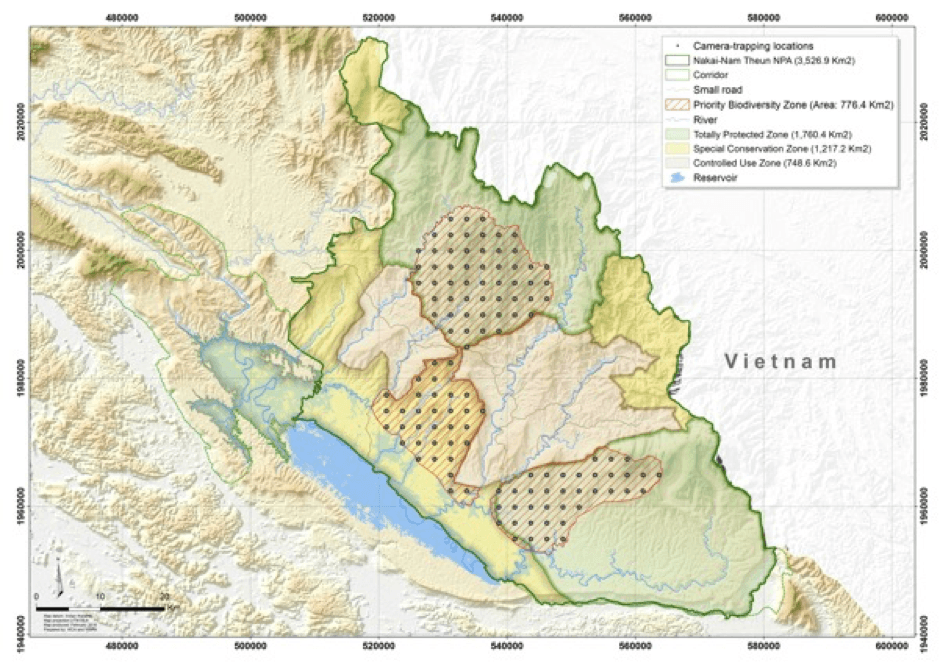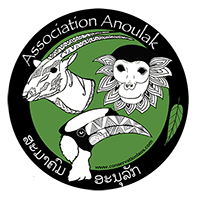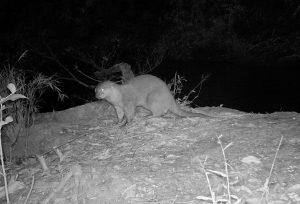Biodiversity research and monitoring for conservation
We are currently working on the following research and conservation projects:
- White-cheeked Gibbons distribution and development of reliable survey methods
- Otter surveys and conservation planning
- Large-antlered muntjac distribution and population monitoring
- Biodiversity surveys and populations monitoring with camera-traps
- Population Survey and monitoring of the Asian Elephants (Elephas maximus) of the Nakai Plateau, Nakai District, Khammouan Province, Lao PDR
- Biological Research, Threat Analysis, and Conservation Activities for Endangered Luciocyprinus striolatus (Paa Kang) in Nakai – Nam Theun National Park, Khammouan Province, Lao PDR
White-cheeked gibbon distribution
INVESTIGATING THE UNKNOWN: DISTRIBUTION OF THE SOUTHERN WHITE-CHEEKED GIBBON NOMASCUS SIKI AND THE NORTHERN WHITE-CHEEKED GIBBON N. LEUCOGENYS IN CENTRAL LAOS
Nomascus gibbons are the most threatened of the four Hylobatidae genera. The Northern N. leucogenys and the Southern White-cheeked Gibbon N. siki are both classified as Critically Endangered. They have a restricted global range and are endemic to Laos and Vietnam. It is currently speculated that the Nam Kading-Nam Theun (river) represents the major geographical barrier between N. leucogenys and N. siki (ranging north and south of the river, respectively). However, in central Laos the distribution range limit between the two species remains uncertain, preventing appropriate conservation planning. Gibbon songs are taxonomically distinct between species. To investigate the distribution of N. siki and N. leucogenys, we collected and obtained from partner institutions a total of 896 gibbon songs from sites in central Laos and Vietnam. We compared these recordings with 213 vocal recordings of genetically-screened gibbon individuals of both species from zoological facilities in Europe. Our dataset contains 674 records from males and 222 records from females. We performed the Kruskal-Wallis test to select acoustic parameters. We used cluster analysis to identify differences in vocalisation among the gibbon populations. Cluster analysis is a multivariate method useful for identifying the same individuals based on the acoustic parameters they assign into clusters. The preliminary results showed that in the area north of the Nam Kading-Nam Theun are groups similar to N. siki while groups south of the river show a mixture of the two species. The results of our research will lead to re-evaluating the global distribution of both species and adapt national conservation prioritisation.
This research is conducted in collaboration with Dr. Hradec from the University of Life Science, Czech Republic.
We are currently working on data analysis and publication of our research.
To learn more about White-cheeked Gibbon singing patterns in Laos, read our publication
Development of gibbon survey methods
GIBBON SURVEYING IN THE DIGITAL AGE
Gibbons are difficult to see and easy to hear, so the best way to detect them is to listen for them. It is easy to establish gibbon presence this way, but not so easy to estimate gibbon density and abundance, which requires information on their locations when calling. Humans doing the listening can estimate directions to calls, and gibbon locations can be estimated by triangulation (although this can be labour-intensive and error-prone). Digital recorders are better listeners than humans in that they are cheaper and don’t get tired. Currently available recorders don’t estimate directions to calls but it turns out that accurate directions to calls is important for accurate density estimation. We introduce new digital recorders with synchronised clocks and multiple microphones which are able to provide estimated directions to sound sources accurately, and show how this improves density and abundance estimation, using acoustic spatial capture-recapture methods. We briefly discuss survey design, how calls can be efficiently extracted from acoustic files, and summarise results from initial field testing. These confirm that use of the new digital recorders with angle estimation substantially improves density estimation as well as provides much better information on sound source locations. They will undergo full field testing in Laos late this year. We hope their use will improve gibbon population monitoring and conservation planning in the near future.
This project is conducted in collaboration with the University of St Andrews, Aarhus University, and Rainforest Connection
Otter surveys and conservation planning
Very little is known of otter throughout Southeast Asia. Three species have been confirmed to occur in Laos (all listed in the IUCN Red List of Threatened Species): Vulnerable Asian Small-clawed Otter Aonyx cinereus, Smooth-coated Otter Lutrogale perspicillata and Near Threatened Eurasian Lutra lutra, but their distribution and conservation status remains unknown. Otters are declining across their range due to precipitous loss of habitat, illegal trade, and decreasing prey base. Information is urgently needed on their distribution, habitat use and local threats to plan conservation actions.
We are collecting data on the distribution and taxonomic status of otter species in Nakai-Nam Theun, in order to adopt long-term effective, on-the-ground conservation strategies for the species occurring in this area.
Read our publication: Coudrat, C.N.Z., Chutipong, W., Sukmak, M., Sripiboon, S., Klinsawat, W. (2022). Taxonomic status of otter species in Nakai-Nam Theun National Park, Lao PDR, based on DNA evidence. Ecology and Evolution. https://doi.org/10.1002/ece3.9601
We are collaborating with the IUCN SSC Otter Specialist Group to contribute to the conservation strategy of otters in Southeast Asia.
Ecological distribution and monitoring of sympatric species of Muntjac species
The Annamites ecoregion harbors exceptional levels of species richness and endemism, but intensive snaring has decimated populations of terrestrial mammals. Ungulates, such as muntjacs, are susceptible to snaring, and in need of effective conservation action. At least three muntjacs occur sympatrically in the region: the Annamite dark muntjac species complex Muntiacus rooseveltorum/truongsonensis, the northern red muntjac Muntiacus vaginalis, and the large-antlered muntjac Muntiacus vuquangensis. We conducted a landscape-scale systematic camera-trapping survey in Nakai-Nam Theun National Park to gather information on the ecology and distribution of these muntjacs. We analyzed camera-trap records within an occupancy framework to evaluate responses to environmental and anthropogenic variables, and to predict distributions across the protected area. We found varying responses to the covariates, indicating complex drivers of occurrence, though all three muntjac had higher occupancies in more inaccessible areas. Mean (95%) PAO in the protected area was higher for large antlered muntjac (0.33 [0.22–0.49]), followed by Annamite dark muntjac (0.28 [0.18–0.39]), and then northern red muntjac(0.27 [0.15–0.42]). Large-antlered muntjac and northern red muntjac were widespread, while dark muntjac was restricted to a single high elevation area. Overall, our results provide new insights into muntjac ecology, distribution, and population status, and we discuss how this information can be used to inform conservation efforts. Given the high occupancies that we found for the Critically Endangered large-antlered muntjac, we argue that Nakai-Nam Theun National Park may be vital for the long-term survival of the species.
Our research and analysis main observations and conclusions are:
- The three species of muntjac show varying responses to the variables, indicating complex drivers of occurrence
- Annamite dark muntjac was predominantly found at higher elevations, consistent with previous qualitative assessments that the species complex is more common in highland areas across its range
- Northern red muntjac occupancy peaked at approximately 1250 m asl., but declined at elevations above this, consistent with previous assessments that in Laos the northern red muntjac may be uncommon above 1500 m asl
- Large-antlered muntjac was predicted to range at higher elevations: contradicting previous speculations that the species predominantly occurs below 1000 m asl due to ecological habitat associations
- All three muntjac had higher occupancies in more inaccessible areas, as their populations are likely depressed by hunting pressure in less remote areas. From a conservation perspective, such a finding is more worrisome for large-antlered muntjac, given its Critically Endangered conservation status (the species is endemic to the Annamite Mountains: a restricted world range)
- The mean Percentage Area of Occupancy across the national park was higher for large-antlered muntjac, followed by Annamite dark muntjac and then northern red muntjac
- Large-antlered muntjac and northern red muntjac were distributed more widely across the national park, while Annamite dark muntjac was restricted to high elevation areas
- Given the high occupancies that we found for the Critically Endangered large-antlered muntjac, we argue that Nakai-Nam Theun National Park may be vital for the long-term survival of the species. Securing large-antlered muntjac, as well as other Annamite endemic species that are still present in Nakai-Nam Theun NP, is critical for the conservation of these species in the Annamite mountains.
- Assessing population changes over time is an integral part of adaptive management: Percentage of Area Occupied (PAO), occupancy estimates, and predictive maps all provide information that can be used to inform conservation decisions in Nakai- Nam Theun NP.
- Our occupancy estimates provide a robust conservation baseline for each muntjac and management zone, which can, in turn, be used to assess population trends and, ultimately, the effectiveness of conservation interventions.
Read ou publication: Alexiou, I., Abrams, J.F., Coudrat, C.N.Z., Nanthavong, C., Nguyen, A., Niedballa, J., Wilting, A., Tilker, A. (2022) Camera‐trapping reveals new insights in the ecology of three sympatric muntjacs in an overhunted biodiversity hotspot. Mammalian Biology. https://doi.org/10.1007/s42991-022-00248-0
Biodiversity surveys and monitoring with camera-traps
We are conducting in collaboration with the Nam Theun 2 Watershed Management and Protection Authority (WMPA) a long-term wildlife monitoring program using systematic camera-trapping methodology with the objectives of:
- Providing baseline data on wildlife population and threats to set specific, pre-defined quantitative management targets;
- Facilitating an assessment of whether wildlife populations and threats are increasing, decreasing or remaining stable as a result of management interventions;
- Obtain data to research on several aspects of biodiversity to inform conservation action and advance scientific knowledge.
We work in collaboration with the Leibniz Institute for Zoo and Wildlife Research (IZW), Germany for a landscape wildlife monitoring approach in the Annamite mountain range; we use a systemic protocol developed by IZW.

Visit our Gallery to look at a selection of our camera-trap photos
To learn more about cats and small carnivores in Nakai-Nam Theun, read our publications.
Population Survey and monitoring of the Asian Elephants (Elephas maximus) of the Nakai Plateau
One of the largest elephant populations of Laos is in Nakai-Nam Theun National Park and surrounding areas. In 2008, a hydroelectric dam led to the flooding part of the elephant population’s habitat. Prior to the impoundment, the population was estimated at 132 elephants, likely the largest and genetically diverse in Laos at the time. But it was suggested that it would be affected and disperse due to the habitat loss. Since the impoundment, elephants have moved closer to villages and human-elephant conflicts have increased across a wide region. The size of the elephant population has not been systematically monitored. Association Anoulak will lead the study of the current status, genetic diversity, movement pattern of this population with implications for the national and global conservation of the species.
Project specific objectives
- To achieve the aim of this study, the following specific objectives are:
- Provide an estimation of the current elephant population size using a non-invasive genetic sampling survey of the population of Asian Elephants on the Nakai Plateau and surrounding areas
- Provide the current status of the genetic diversity and social structure of the population of Asian Elephant on the Nakai Plateau and surrounding areas
- Inform a future site-based multi-stakeholders Elephant Conservation Plan
Project broader impact/value
- Given the global conservation status of Asian Elephant across Southeast Asia, any viable population is of global conservation value.
- This project is the first phase towards the development of a long-term elephant conservation plan for the target area.
- This project is in line with Lao Governement’s National Elephant Conservation Action Plan.
- The information obtained from this project will provide valuable scientific data on the current status of the population, which will in turn be used to develop follow-up activities for the conservation of the species (eg. human-elephant conflict mitigation; population monitoring program etc.).
- In addition, the Nakai-Nam Theun National Park will soon open ecotourism tours, which will attract Lao and foreign tourists: the study of the elephant population may also increase the chances to observe them in the wild, a rare chance in Laos.
This project is conducted in collaboration with Institut de Recherche pour le Developement-Laos; CNRS-Montpellier/Beauval Nature; Royal Zoological Society of Scotland.
Funded by: Conservation, Food & Health Foundation; International Conservation Fund of Canada; Wilhelma Foundation; Denver Zoo
Biological Research, Threat Analysis, and Conservation Activities for Endangered Luciocyprinus striolatus (Paa Kang) in Nakai
Luciocyprinus striolatus is a species of endangered cyprinid native to parts of Laos and China. It is listed as Endangered on the IUCN Red List of Threatened Species (IUCN, 2021). The abundance of the species is thought to be rapidly declining due to various impacts from human activities including deforestation, infrastructure and hydropower development, low water levels, the use of destructive fishing gears, and climate change. The species is believed to be already extinct from China, which makes Laos the only country where the species can be protected. The distribution of the species in Laos remains little known, as well as the threats it faces where the species has been confirmed.
There are currently only two locations in the country where the species has been recorded: (1) Nam Pak river, a tributary of the Nam Ou river in Oudomxay Province, northern Laos and (2) Nam Kading/Nam Theun river, a tributary of the Mekong river, in Khammouan Province, central Laos. There have also been unofficial reports of the species in the Nam Young/Nam Herng rivers, tributaries of the Nam Kading, in Bolikhamxay Province, central Laos.
The current status of the species in Nakai – Nam Theun National Park is unknown, therefore a research and conservation project is urgently needed to ensure the long-term conservation and survival of the species locally, if it still occurs.
This project was implemented with technical partner FISHBIO (USA, Laos) with a grant received from IUCN/CEPF, and local government partner Nakai-Nam Theun National Park.
Association Anoulak provided funding for field implementation in Nakai-Nam Theun National Park via grants received from Mandai Nature and Association Francaise des Parcs Zoologiques (AFDPZ).
RECOMMENDATIONS:
Based on this pilot project, the final recommendations for the protection and conservation of wolfbarb in Nakai-Nam Theun National Park are as follows:
- Conduct a follow-up study to understand the species’ reproductive cycle in Nakai-Nam Theun, including the identification of key locations of reproduction and spawning.
- Set up community-based Fish Conservation Zones within the national park targeted for wolfbarb.
- If possible, avoid the practice of catch-and-release sport fishing in Nakai-Nam Theun National Park, as this park represents the best location in the world for the long-term conservation of the species.
- If sport fishing is unavoidable, conduct an impact assessment and define appropriate regulations prior to authorizing and promoting this practice in the park.
- Develop community-based ecotourism to observe the species in its natural habitat. Any ecotourism projects must directly benefit the local communities and ensure their involvement in the protection of the species, notably through community-based Fish Conservation Zones.
- Conduct awareness-raising for local authorities and local communities on the conservation value of the species.

